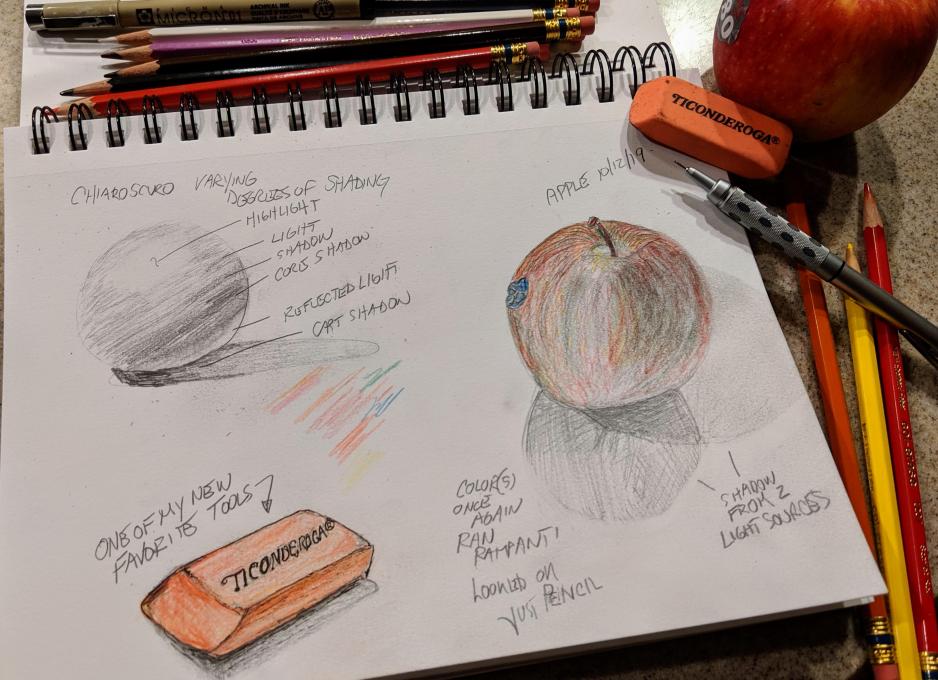The Cornell Lab Bird Academy › Discussion Groups › Nature Journaling and Field Sketching › Illustrating the 3D World
-
I'm finding this very challenging, but what I draw is better than I thought it would be. I need to work on changing value from light to dark to that it is gradual, rather than abrupt.
-


-
I love your mark-making!
-
Love your style.
-
-
 I am still struggling for the reflective light and shadows but I am improving. Like others, it did help to watch some videos to gain further understanding. Sketching is quicker when filling in values of light and dark. I am definitely getting more comfortable with the process and enjoy looking back on the sketches I've done so far.
I am still struggling for the reflective light and shadows but I am improving. Like others, it did help to watch some videos to gain further understanding. Sketching is quicker when filling in values of light and dark. I am definitely getting more comfortable with the process and enjoy looking back on the sketches I've done so far. -
I tried! I think this will be easier to accomplish with the paints and color. I noticed some of you are venturing into the watercolors or colored pencils and it helps to bring out the actual lights and darks apart from color and texture. The cast shadow was the most difficult part for me.

-
 Requires a lot of practice, but lots of fun.
Requires a lot of practice, but lots of fun. -
Interesting to see other's drawings so will try uploading one - I am enjoying the challenges and coaching. This carving also has a lovely rough style of etchings that were fun to try to represent.

-
Getting the chiaroscuro along with the lights and darks of the skin tone of my pear was a challenge. The skin in the brightest part was a darker green than the yellowish skin in the shadow area where the pear gets narrow, and I wasn't sure how to represent that. I'd include a picture of the pear but I ate it! (Destroying evidence)

-
This is a very elegant, believable pear. Sorting out The light and dark values from the colors can be challenging. I think you did that well,
-
Nice.
-
-

 I've enjoyed practicing these drawing skills. It seems to take me forever to draw a simple object. I expect my confidence will improve with practice. I can't imagine taking this much time while drawing in the forest. The days are shorter here in British Columbia I'd be drawing in the dark lol! Haven't tried fruit yet. Great to see everyone's art!
I've enjoyed practicing these drawing skills. It seems to take me forever to draw a simple object. I expect my confidence will improve with practice. I can't imagine taking this much time while drawing in the forest. The days are shorter here in British Columbia I'd be drawing in the dark lol! Haven't tried fruit yet. Great to see everyone's art! -
Good economy of line. Less (lines) can be more (satisfying(!
-
-
 This is fun I need to try some hash marks and convince myself they belong. I always feel like they are inappropriate for my subjects but then I see others use them for nature subjects and they look great .
This is fun I need to try some hash marks and convince myself they belong. I always feel like they are inappropriate for my subjects but then I see others use them for nature subjects and they look great .
-
It might be easier if I drew an apple and then went to the store to find one that looks like my drawing! This is a great course, I'm learning and having fun.

-

-
This will take some practice, but the clear instructions provided give me a starting point for adding dimension to my drawings.

-
That shell was more difficult than I had expected. But I don't have any fruit to practice on. This is so much fun!

-
My first attempt.

-
This is really good!
-
@Sharla Thank you Sharla
-
Looks great! 👍🏻
-
-
This course is great! I needed something to get me back at it again and I need to do much more! Preparing for a trip next year that I hope to illustrate during the journey.

-
-
Having fun with these exercises. I need a lot of practice with light and shadow!!
-
 It was very hard to get the three dimensions of the apple
at first. I felt stuck. Then I watched a video that gave some hints. That helped me get started. Now I am excited to try another drawing. Bring on the fruit!
It was very hard to get the three dimensions of the apple
at first. I felt stuck. Then I watched a video that gave some hints. That helped me get started. Now I am excited to try another drawing. Bring on the fruit! -
Harder than it looks. I keep running into texture along with dark and light. I suppose I need to find things with uniform textures to practice shadows, and things with uniform lighting to practice textures. Things with both make it really hard to decide how to proceed... I also wish I had a good way to upload. Scanning is slow and takes about 5 separate steps to get the picture loaded. Maybe I should join the 21st century and get a phone with a camera? I did do a couple of small sketches that weren't too bad. I'll try to upload them later.
-
Some lovely drawings have been posted. Here is something more natural than the bowl I posted earlier. Getting used to shading a bit more.

-
It was hard for me to find where the light and the dark spots were on the object, I found that it was easier to first take a photo of it, and that brought out some of the more obvious chiaroscuro. I am feeling more comfortable on putting the marks on pages, I am finding that I am more capable of doing these things than I think.
-


 Definitely getting a feel for which shading techniques work for me on which subjects. Stippling on lemon worked well, I think. I'm not so sure about cross-hatching on pomegranate, but maybe it works.
Definitely getting a feel for which shading techniques work for me on which subjects. Stippling on lemon worked well, I think. I'm not so sure about cross-hatching on pomegranate, but maybe it works. -
The pomegranate looks good enough to eat! I love the way you use colour there. The shadow cast by the pomegranate is a bit rough and ready, but the fruit itself is stunning. Love it!
-
@Victor Thank you! Yeah, I'm not too happy with the shadow. I think I should have blended it more ...
-
Nice! These feel both personal and real. I'm inspired by how well the watercolor with pencil is working together.
-
@Kathryn Thank you! I'm still getting the feel for the watercolors and how they work with the pencil. I've used watercolor pencils before, and colored pencils, but never watercolors with pencil drawings. Fun to see how it all works together ...
-
-

-
This was also hard for me. But I did do a few drawings.
 I couldn't pull myself to try to add color to it.
Then my grandson wanted me to draw his backpack, so I thought I'd try it.
I couldn't pull myself to try to add color to it.
Then my grandson wanted me to draw his backpack, so I thought I'd try it.
 Next, my granddaughter wanted a drawing of a shell.
Next, my granddaughter wanted a drawing of a shell.
 I'm enjoying really looking at the object.
I'm enjoying really looking at the object. -
Gettin' down & dirty (ie, too much pencil, shading, color, etc!) Enjoyed the explanation of shadow (and learning that new, cool word "chiaroscuro") and I can see that this parameter--shading--will take a lot of practice yet will lead to drawings that I will come to enjoy more (the process and the end project).

-
I really like the style in which Liz is instructing us. It’s early in this course, yet I feel like I’m learning so much! I’m sure everyone else agrees. I am ready to move on, but no doubt I’ll go back to the prior units for a refresher as needed. I’m s happy I took this course.
Read More:

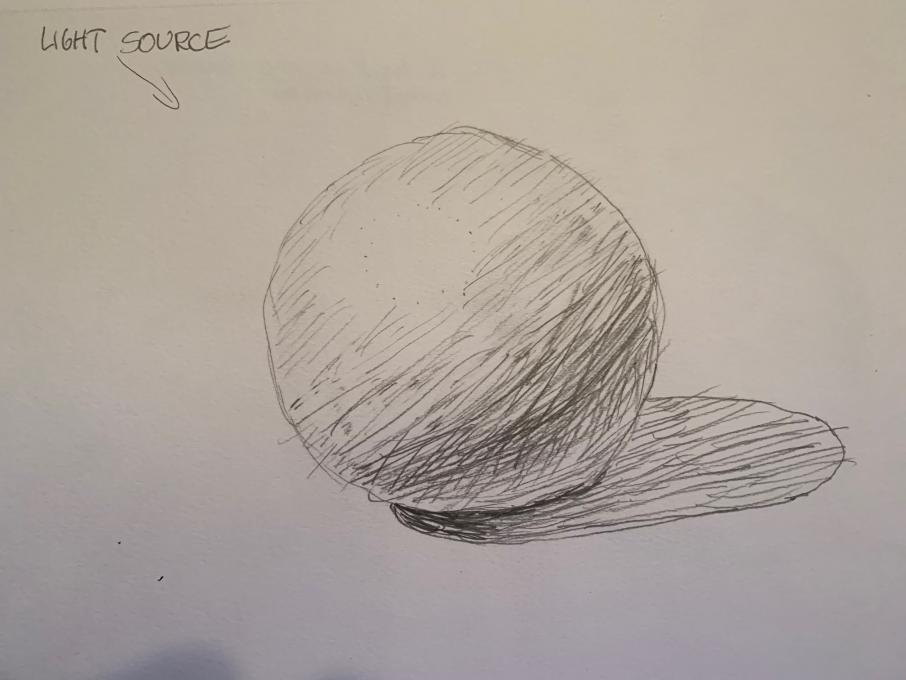
 I am still struggling for the reflective light and shadows but I am improving. Like others, it did help to watch some videos to gain further understanding. Sketching is quicker when filling in values of light and dark. I am definitely getting more comfortable with the process and enjoy looking back on the sketches I've done so far.
I am still struggling for the reflective light and shadows but I am improving. Like others, it did help to watch some videos to gain further understanding. Sketching is quicker when filling in values of light and dark. I am definitely getting more comfortable with the process and enjoy looking back on the sketches I've done so far. 
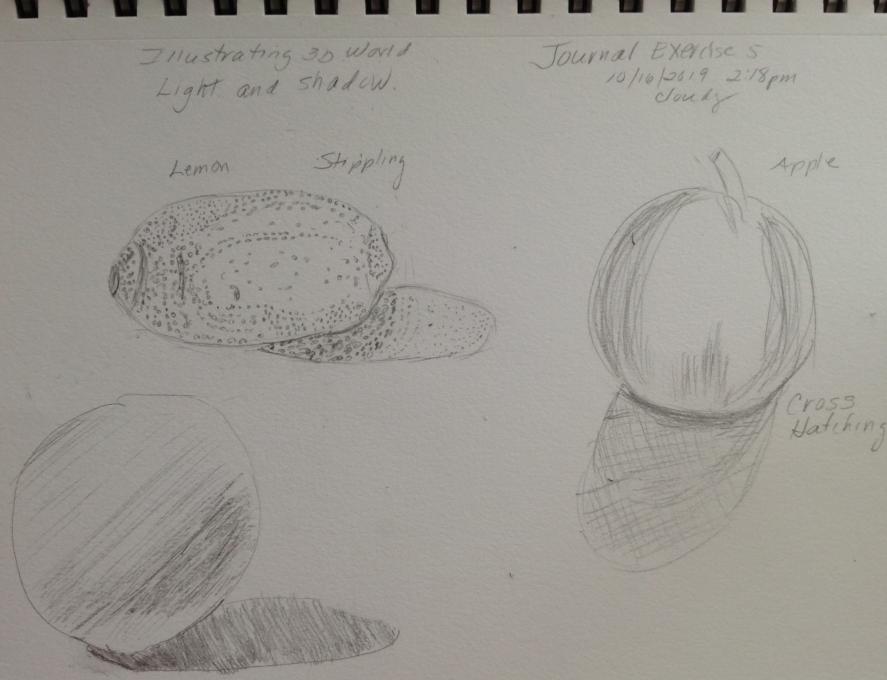 Requires a lot of practice, but lots of fun.
Requires a lot of practice, but lots of fun. 
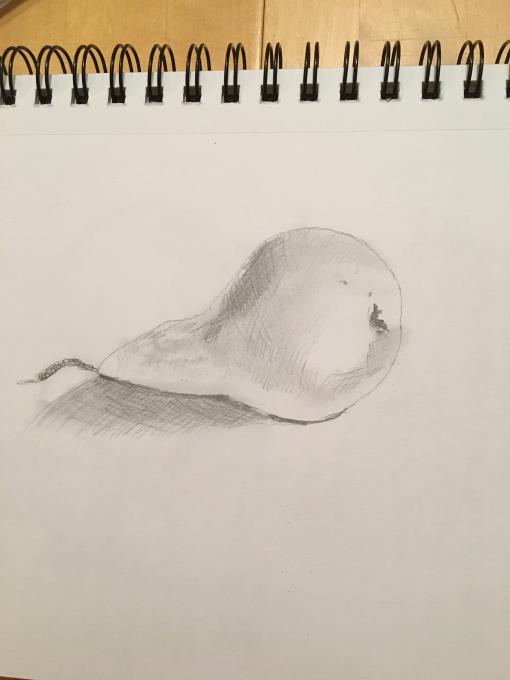
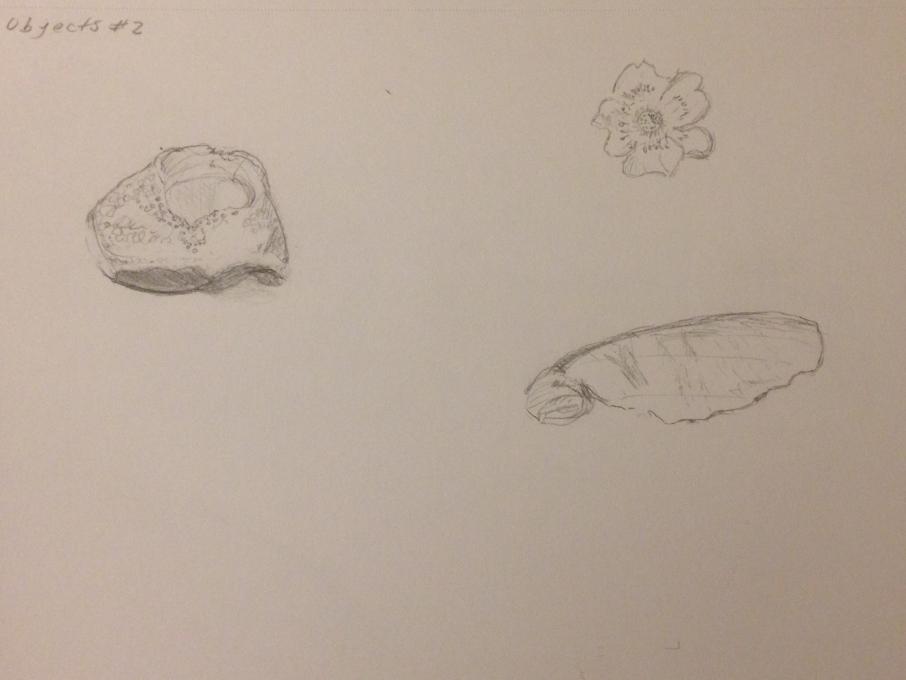
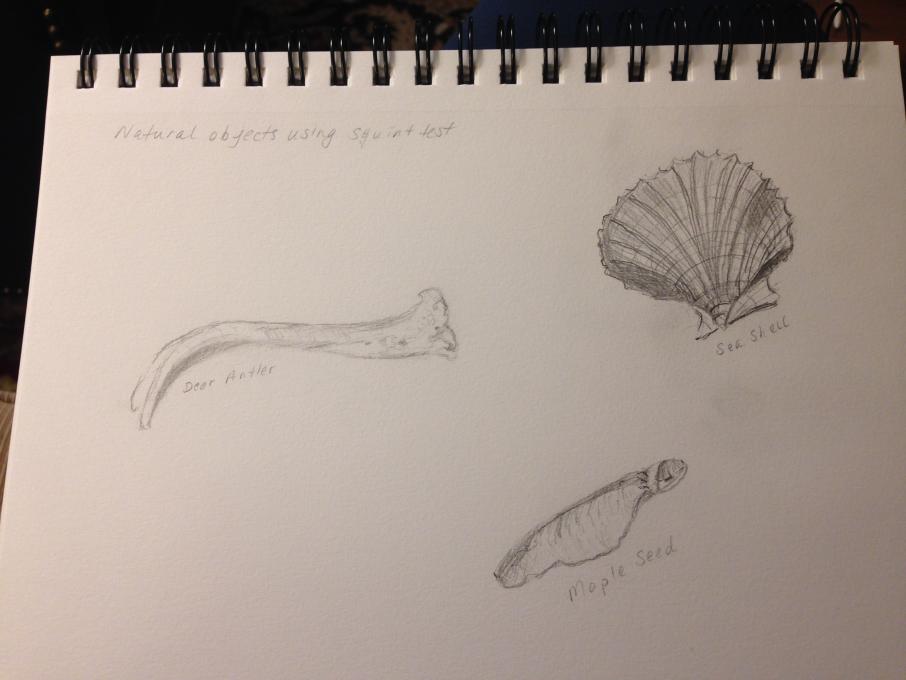 I've enjoyed practicing these drawing skills. It seems to take me forever to draw a simple object. I expect my confidence will improve with practice. I can't imagine taking this much time while drawing in the forest. The days are shorter here in British Columbia I'd be drawing in the dark lol! Haven't tried fruit yet. Great to see everyone's art!
I've enjoyed practicing these drawing skills. It seems to take me forever to draw a simple object. I expect my confidence will improve with practice. I can't imagine taking this much time while drawing in the forest. The days are shorter here in British Columbia I'd be drawing in the dark lol! Haven't tried fruit yet. Great to see everyone's art! 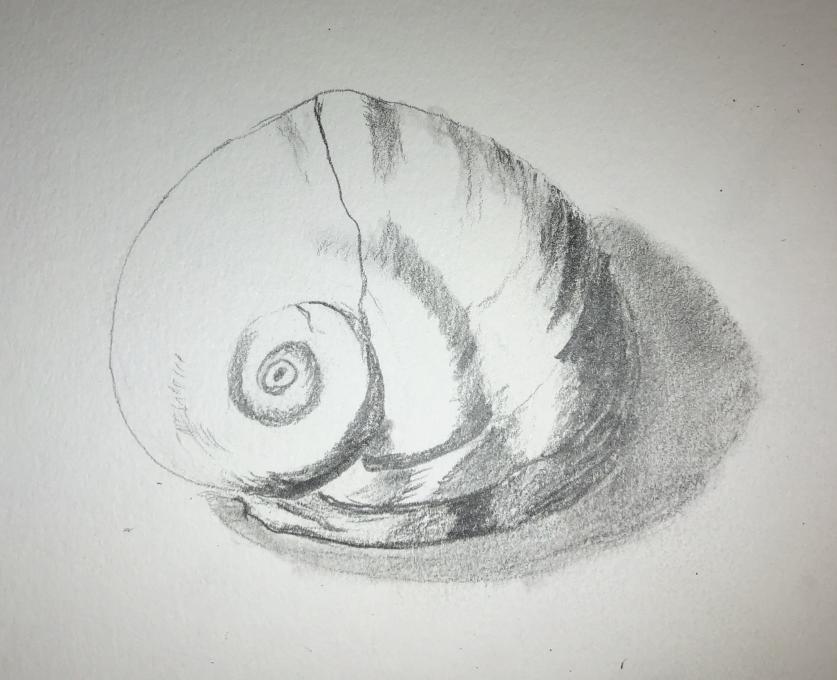 This is fun I need to try some hash marks and convince myself they belong. I always feel like they are inappropriate for my subjects but then I see others use them for nature subjects and they look great .
This is fun I need to try some hash marks and convince myself they belong. I always feel like they are inappropriate for my subjects but then I see others use them for nature subjects and they look great .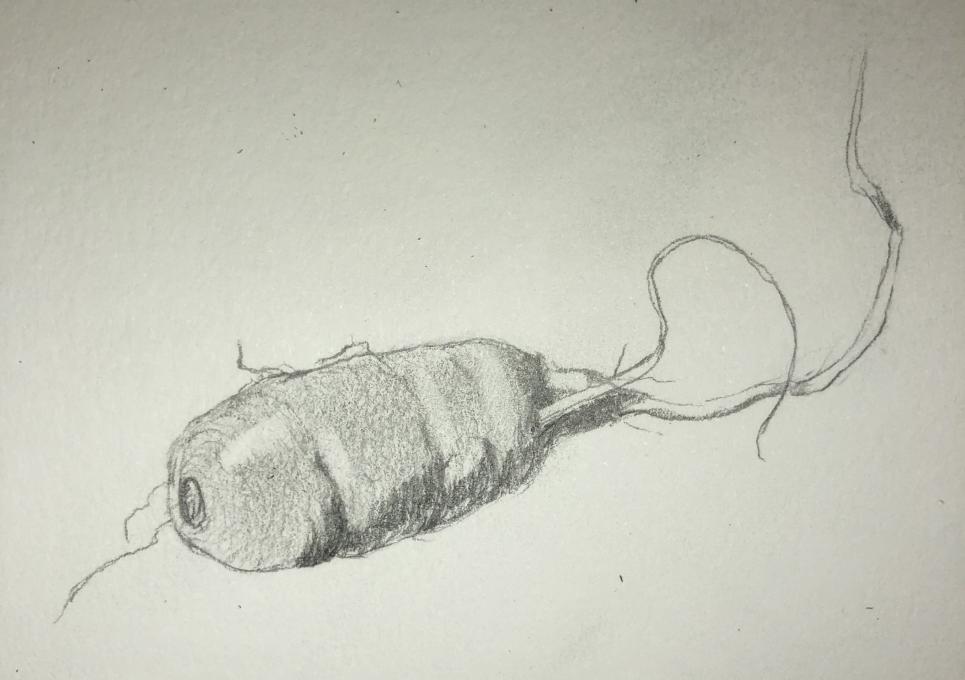
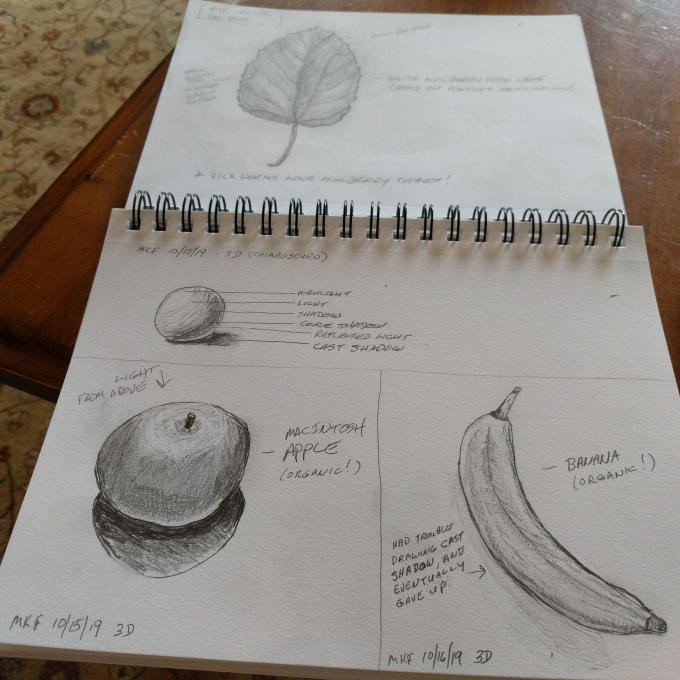
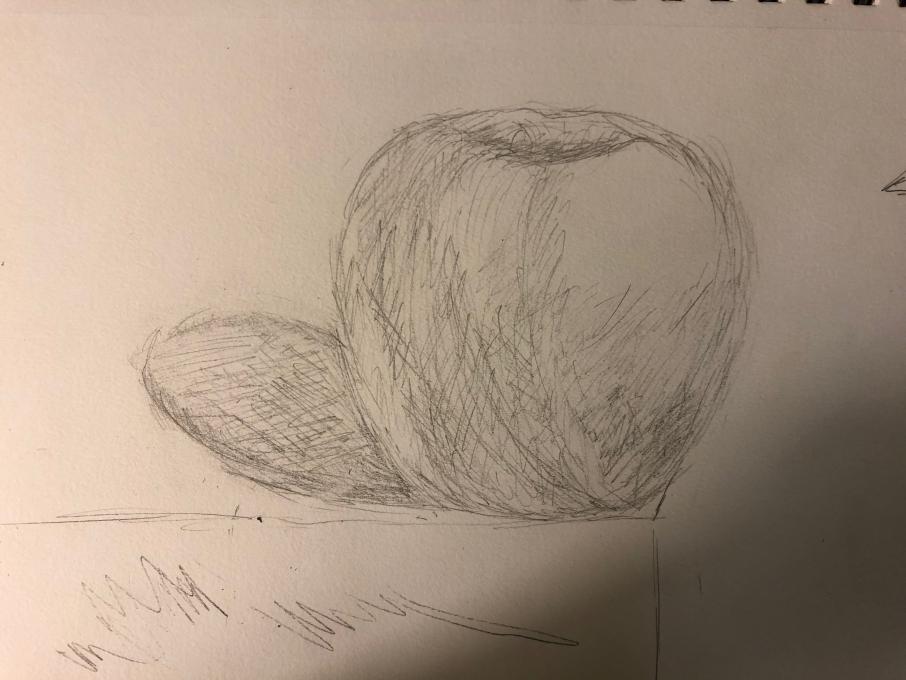
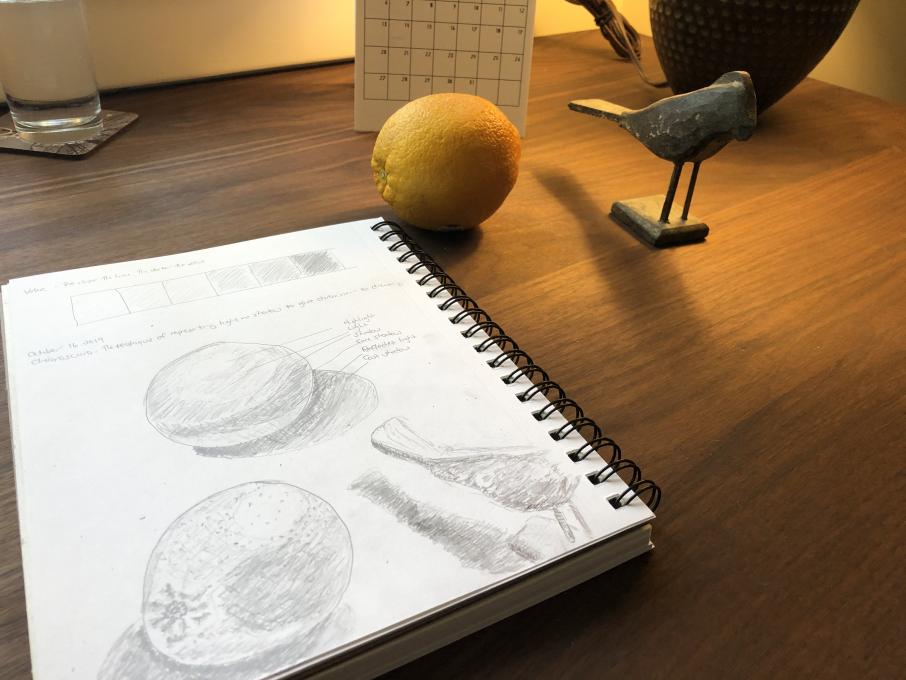
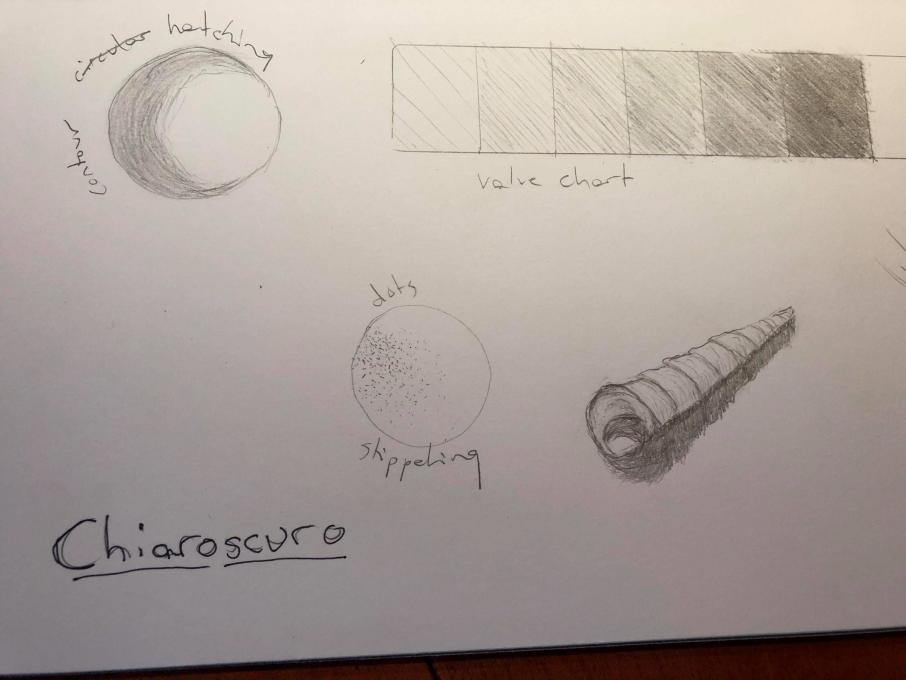

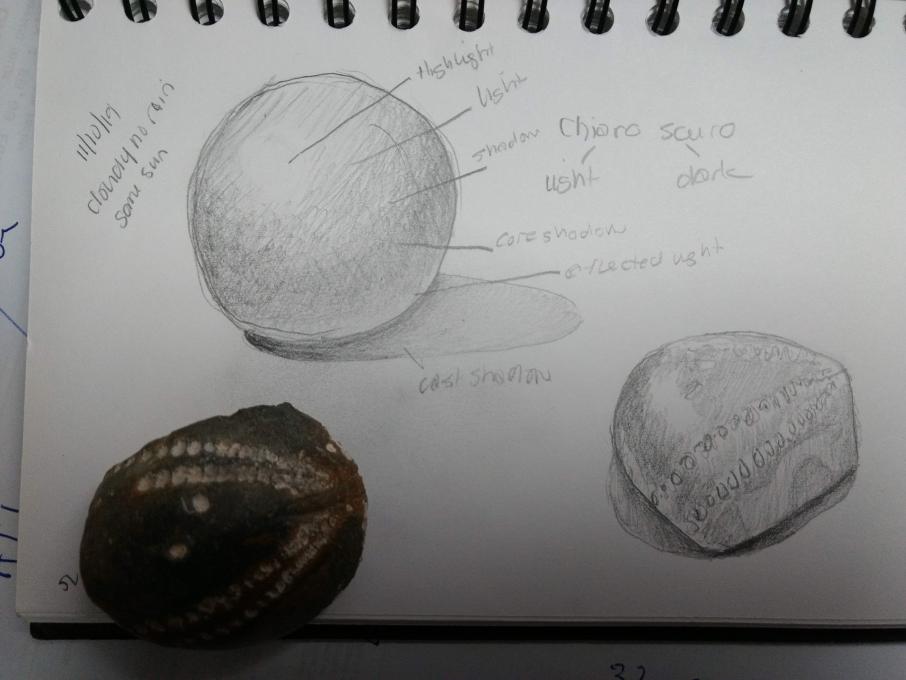

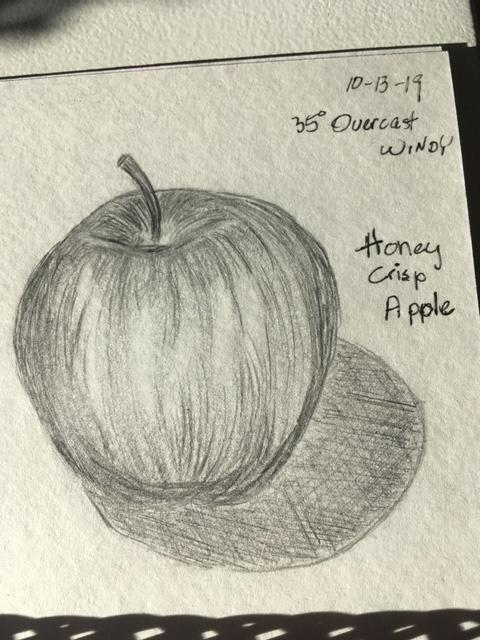 It was very hard to get the three dimensions of the apple
at first. I felt stuck. Then I watched a video that gave some hints. That helped me get started. Now I am excited to try another drawing. Bring on the fruit!
It was very hard to get the three dimensions of the apple
at first. I felt stuck. Then I watched a video that gave some hints. That helped me get started. Now I am excited to try another drawing. Bring on the fruit! 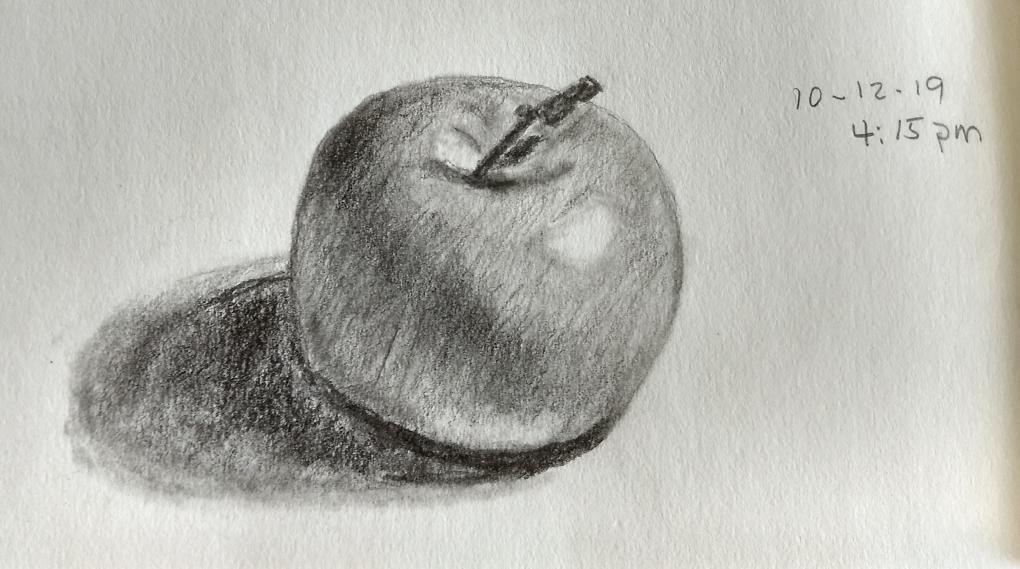
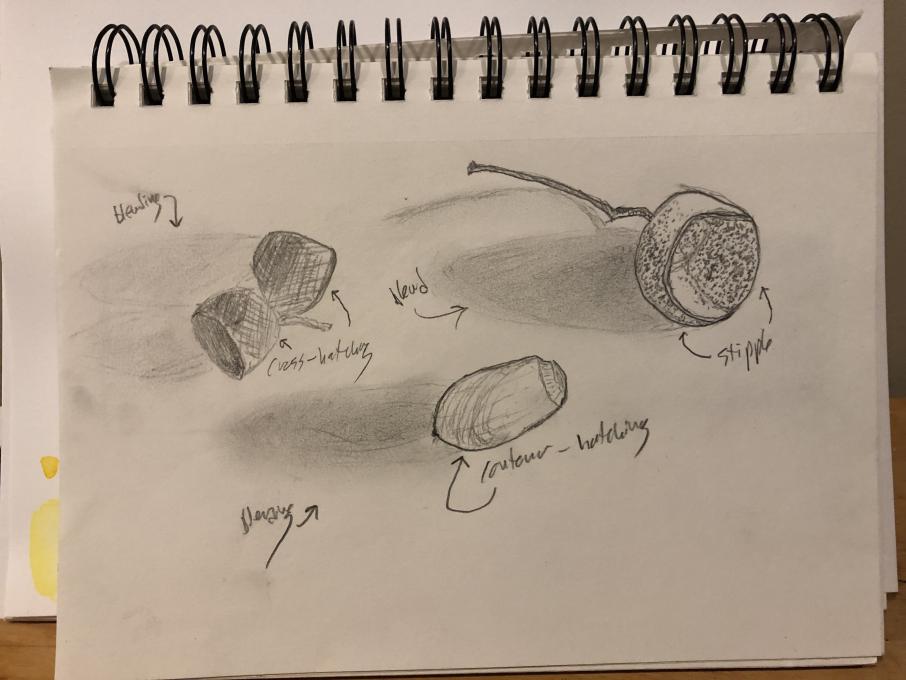

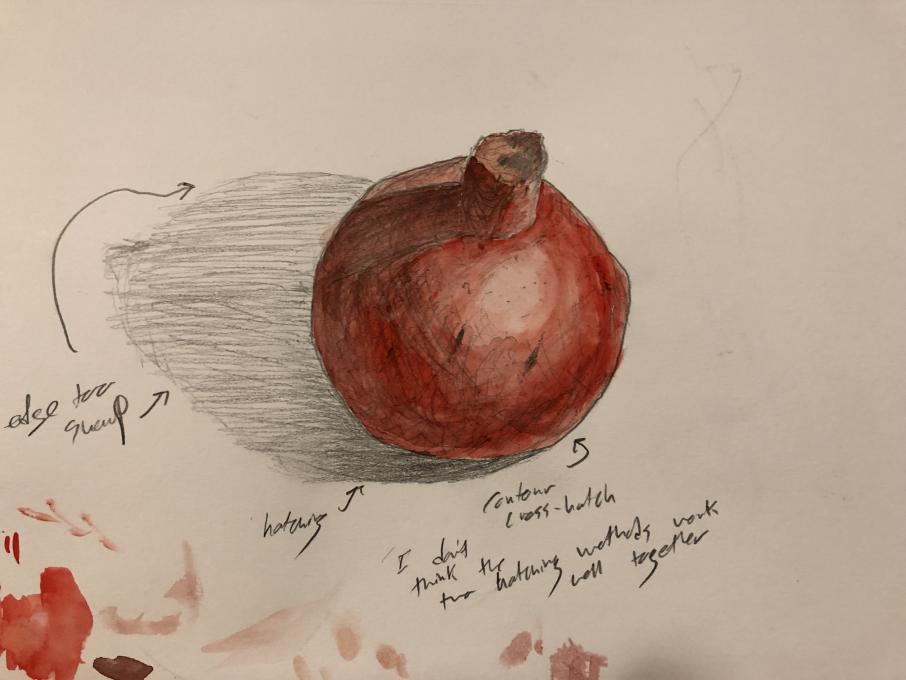 Definitely getting a feel for which shading techniques work for me on which subjects. Stippling on lemon worked well, I think. I'm not so sure about cross-hatching on pomegranate, but maybe it works.
Definitely getting a feel for which shading techniques work for me on which subjects. Stippling on lemon worked well, I think. I'm not so sure about cross-hatching on pomegranate, but maybe it works. 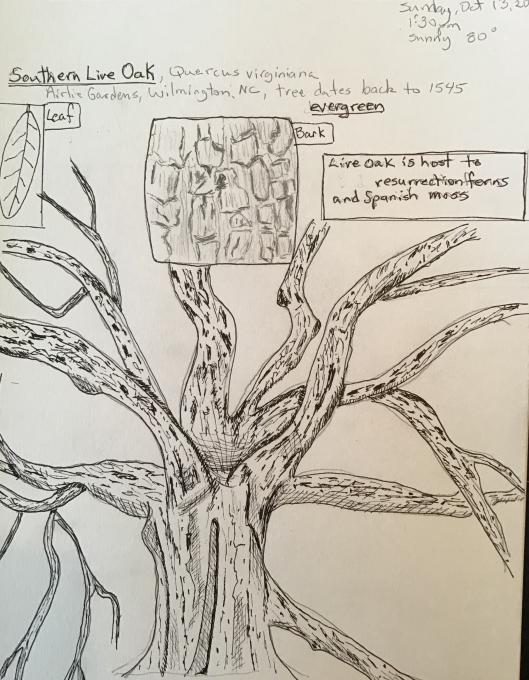
 I couldn't pull myself to try to add color to it.
Then my grandson wanted me to draw his backpack, so I thought I'd try it.
I couldn't pull myself to try to add color to it.
Then my grandson wanted me to draw his backpack, so I thought I'd try it.
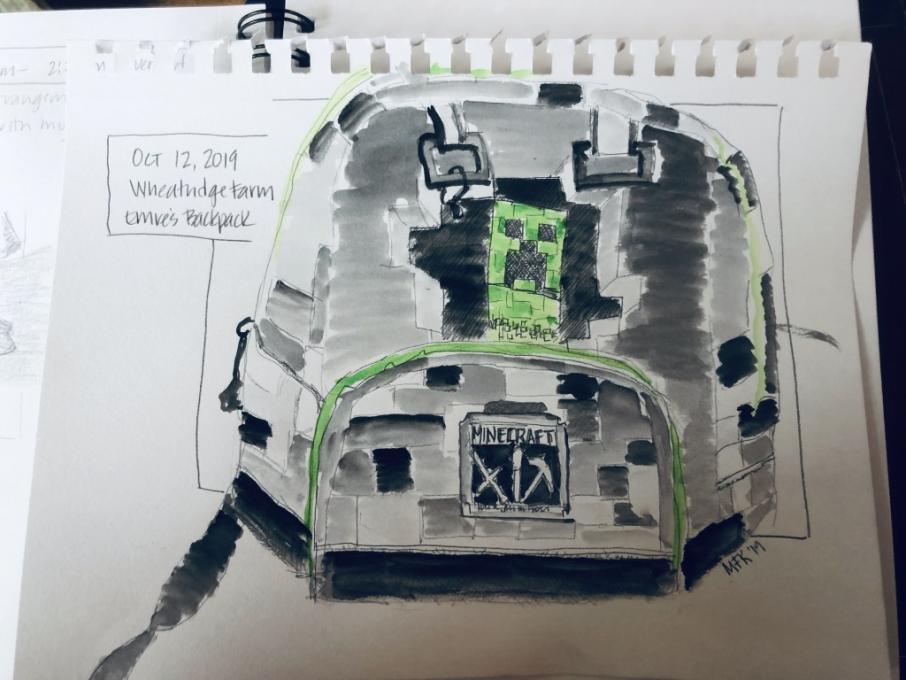 Next, my granddaughter wanted a drawing of a shell.
Next, my granddaughter wanted a drawing of a shell.
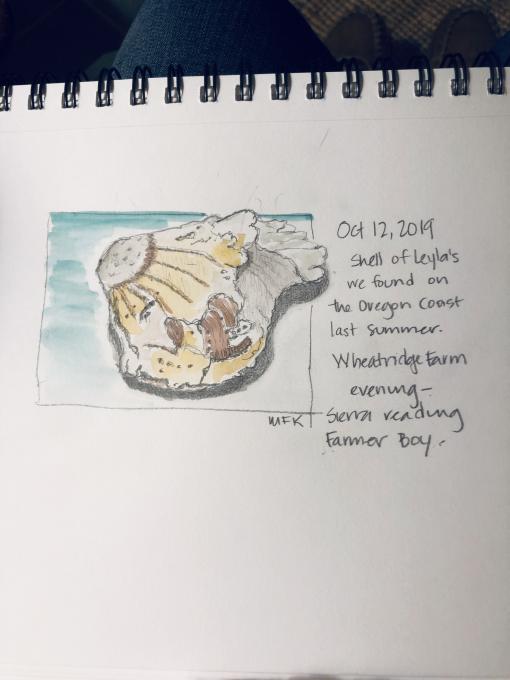 I'm enjoying really looking at the object.
I'm enjoying really looking at the object. 